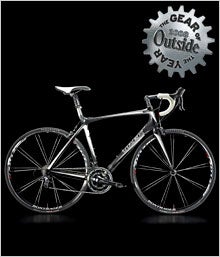1. Want race-proven? Trek’s all-new Madone is available in three levels of carbon (White, Black, and Red). Because the top-tier Red frames weren’t done in time, Alberto Contador won last year’s Tour de France on a mid-level Black frame, exactly like the one shown here.
2. Stiffer bottom brackets mean more efficient pedaling. By engineering the Madone so that crank bearings fit into the frame, rather than on the outside, Trek delivers the widest bottom-bracket junction in the industry. The design also requires fewer parts, which saves weight.
3. Integrated seat masts deliver a more tuned ride quality. But they have to be sawed off—irreversibly—to fit the rider. To get around this, the Madone uses a cap that slides over the seat mast, combining the benefits of integrated designs with the adjustability of traditional posts.
4. Shimano’s lustrous new Ultegra SL component group is only seven ounces heavier than Shimano’s flagship Dura-Ace but at a fraction of the cost. Given that Ultegra already came close to Dura-Ace performance levels, SL will satisfy all but the most finicky of riders.
5. A new fork design eliminates sharp angles, meaning a continuous curve to the carbon threads for better strength and road feel. Trek also claims 39 percent more vertical compliance over the previous Madone, meaning a frame that devours road chatter.
16.2 lbs, 56cm; trekbikes.com


